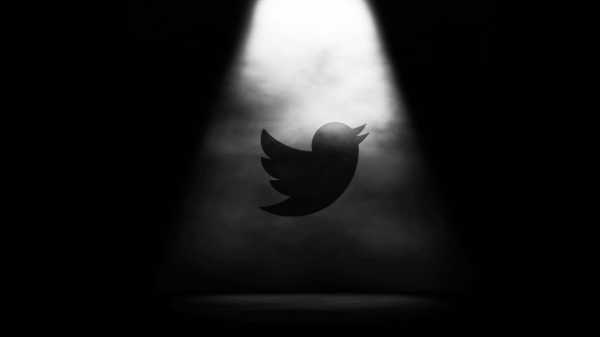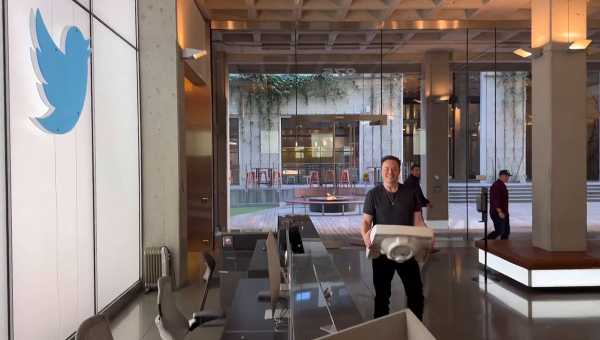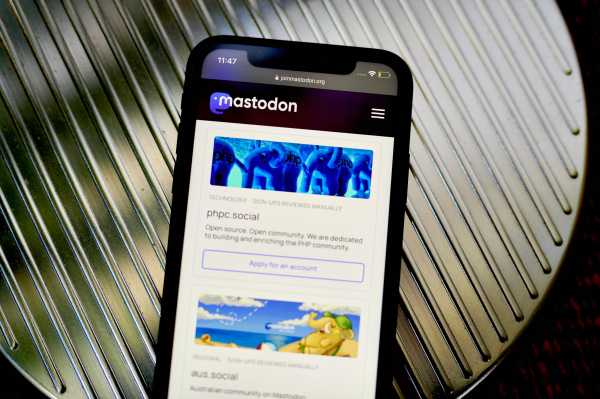
We don’t need another Twitter
Twitter never fulfilled its promise. Don’t expect its current crop of replacements to, either.
By Sara Morrison Dec 6, 2022, 12:30pm EST
Share this story
- Share this on Facebook
- Share this on Twitter
- Share All sharing options
Share All sharing options for: We don’t need another Twitter
This story is part of a group of stories called

Uncovering and explaining how our digital world is changing — and changing us.
Justin Halpern has more reason to love Twitter than most of us. The 28-year-old had trouble finding a writing job in Hollywood, so he moved back in with his parents in 2009 and started @shitmydadsays, where he posted all the shit his dad said. The account quickly went viral. By 2010, he had a book and a TV series based on it. He’s now an executive producer on Harley Quinn and Abbott Elementary.
“Twitter basically jump-started my entire career,” Halpern told Recode.
But @shitmydadsays has been dormant for years, and Halpern doesn’t tweet much anymore from his personal account. He says he went from posting daily, to weekly, and now mostly uses it to keep up with the news.
“I realized I felt much better the less I used the site,” he said.
Halpern’s move away from Twitter predates Elon Musk’s takeover by several years, and it’s indicative of some of the problems Twitter was facing before Musk came along. Twitter has always had an outsized impact as a major driver of news, thanks to who uses it and how. But that’s a fraction of the number of people who use competing platforms. Like Halpern, some of Twitter’s power users had significantly reduced or even stopped their usage of the platform, and user growth overall has slowed.
Now that Musk owns the site and prepares to launch his “Twitter 2.0,” it almost certainly won’t be the same. So a lot of people will be looking for a Twitter replacement. Some possibilities have already emerged, like Mastodon and Post.
We may not need another Twitter, or even the one we have now. But it did show us what a digital town square could be, even if Twitter itself never actually was one. Whatever replaces that, if anything, may not look much like Twitter. It may not even be text-based.
“The last great public text medium”
Twitter’s major needs are users and revenue, and it has struggled to get both. Back in 2014, the Atlantic wrote a (preemptive) “eulogy” for Twitter, citing less active users, less fun, and more spam and abuse. Eight years later, Reuters reported on internal Twitter documents that said the platform’s most active users, who generated 90 percent of its content, were leaving.
“Twitter’s power was to be like a wire service for the 21st century”
As for the money, Twitter has never been very good at making it. It has only turned a profit in two years of its entire history: 2018 and 2019. Its user base of around 240 million active accounts is a fraction of Facebook, Instagram, and TikTok — each of which boasts users in the billions.
“Twitter’s US user base was already in decline prior to the takeover by Musk,” said Jasmine Enberg, principal analyst for social media at Insider Intelligence. “Now, under Musk, those declines are going to accelerate.”
But Twitter also serves a function those other platforms don’t, and it’s why it has lasted as long as it has.
“Twitter’s power was to be like a wire service for the 21st century,” explained Emily Bell, director of Columbia University’s Tow Center for Digital Journalism. “Yes, it’s your celebrities, but it’s also your companies, your politicians, your news organizations, your academics — people who are engaged in knowledge production. Or, indeed, shitposting.” (
But while the news wire was a one-way information stream, Twitter is interactive. It’s how a lot of people who are responsible for disseminating information both collect and distribute it. That has outsized impacts on the rest of the world. Even if you’ve never used Twitter, it can have a profound effect on your daily life, or at least on the news you read.
“It is perhaps the last great public text medium,” said Ethan Zuckerman, director of the UMass Initiative for Digital Public Infrastructure.
Musk seems determined to upend that, proposing changes that drive away, if not antagonize, Twitter’s most active users, advertisers, and even the average person who only uses Twitter to keep up with the news. The billionaire believes that Twitter is dominated by the “media elite” and part of mainstream media’s “oligopoly on information.” He says he wants Twitter to be a place where “citizens” can compete with those journalists, but he also wants to charge users $8 a month to have their tweets pushed above all the spam tweets that Twitter is increasingly filled with. Musk is also determined to loosen up Twitter’s moderation and rules, saying it’s in the interests of free speech. But some of the “free speech” on unmoderated Twitter is bound to be stuff its users and advertisers don’t want to see, and, in some cases, could be harmful to society.
“Musk gave advertisers the reason they were looking for to pull the plug on Twitter,” Enberg said.

Not just the advertisers. Users are looking at other options, even as Musk claims that new user signups are higher than ever. Whoever remains when the dust clears may see a very different platform. Aside from the increased hate speech and newly restored accounts run by avowed white supremacists, there’s also whatever Twitter looks like for people who don’t pay for Twitter Blue. Musk has made it clear that they will have a much worse experience on Twitter than its paying users, their tweets treated as little more than spam.
Musk called Twitter a “digital town square,” and we now know that Musk’s vision of that includes a monthly entrance fee and Musk himself being the sole arbiter of what’s allowed to be said in it. If Twitter ever was a digital town square in the first place, it won’t be one soon. So what fills that void?
Mastodon is the early leader, but it won’t be enough for most people
Prior to purchasing Twitter, Musk wondered if he should build his own version. He tweeted, “is a new platform needed?”
After he bought Twitter, a lot of people started asking the same question. A number of existing platforms have emerged as potential Twitter replacements, and there are more in the works now. And while there’s certainly an interest in an alternative to Twitter, that alone doesn’t guarantee success.
It’s impossible to replicate the conditions that helped create Twitter back in 2006 because they no longer exist. The internet was a different place than it is today, down to how most of us access it (through web browsers, since the iPhone had yet to be invented), and a lot of what Twitter is now wasn’t even part of its founders’ vision. Many of the features that are inextricably associated with Twitter today — retweets, quote tweets, hashtags, and “threads” of multiple posts — were created by its users.
“Lots of features on Twitter developed as a kind of demand from how a particular community used it,” Bell said. “You can create the technology, but you can’t anticipate the community and what it’s going to do with the technology.”
We also know that past attempts to create Twitter clones haven’t panned out. Several companies tried to capitalize on conservatives who thought Twitter was too biased toward liberals: Gab, Parler, GETTR, and Truth Social. They’ve all had a hard time attracting users and money, and some of them are little more than echo chambers with a side of virulent racism (in the name of free speech).
At least one platform hopes to capitalize on the latest Twitter exodus. Post, which launched just a few weeks ago, is in very early beta stages with just over 100,000 users, but it has managed to attract some of Twitter’s power users and a good number of its journalists. This makes sense, as journalists and people who follow them appear to be Post’s target audience, but it remains to be seen if Post will get widespread adoption or simply be another echo chamber with limited outside interest.
There are also Twitter-like platforms whose creation pre-date Musk’s takeover: cohost, CounterSocial, and Hive Social, to name a few. They have their own pros and cons, but they don’t have anything close to Twitter’s scale, even as they’ve enjoyed user bumps in the last month. Some of them simply aren’t ready for primetime. Hive Social, for instance, says it has 2 million users. But it only has three people working on it, and it refuses to disclose the last names of two of them. It’s also, literally, unusable, as it temporarily shut down after multiple severe security issues were found.
And that brings us to Mastodon, which seems to have emerged as the leader in the Twitter alternative wars. This makes sense, since Mastodon has been the Twitter refuge of choice for previous Twitter exoduses since it launched in 2016. It now has 5.6 million users, of which 2.6 million are active. Mastodon looks like Twitter and does a lot of the same things. But it’s not the same, and people who hope or expect it to be have been unpleasantly surprised. Mastodon is just harder to use than Twitter.

Unlike Twitter, which is just one centralized platform for all of its users, Mastodon is made up of a network of thousands of “instances,” or servers, that operate independently while also being able to interact with each other (sort of like how you’re able to email people even if they have different providers). Different servers have different focuses, some based on common interests and some based on location. Some have thousands of users, and some have a few dozen. If you don’t like the server you chose, you can pick up and move your account, followers, posts, and all, to a different one. You can see why that’s especially appealing to some people now.
But you can also see why people are so used to having everything and everyone on one platform whose algorithms help them find interesting accounts or tell them what’s being talked about by a lot of users will be turned off by Mastodon, a place that does none of those things.
Mastodon is the most popular of the Twitter alternatives for now. But it won’t, by design, become the world’s water cooler or modern newswire that Twitter became.
“What else do we lose in losing a medium where lots of people are talking all over the globe, open to be heard by hundreds of millions of people?” Zuckerman said. “That seems much harder to recreate.”
The Twitter of tomorrow isn’t here today
Twitter probably will endure in some form. It’s become too important for all of its users to just pull up stakes and leave. But Musk’s takeover may have significantly shortened its lifespan. The next Twitter, whenever it emerges, may not look much like Twitter at all.
Will a younger generation that loves video-based apps like TikTok and YouTube have any interest in producing or consuming text? How much longer will tapping on tiny phone screens be the primary way most of us interact with the internet? Will the internet continue to essentially be run by a few profit-driven entities?
Bell, for one, would like to see platforms like Twitter become public utilities or services meant to serve the public interest first. She points to Wikipedia — a nonprofit that doesn’t accept ads and is one of the most visited websites in the world — as an example. And sure, Wikipedia is successful. But Mastodon is also a nonprofit public interest project, and it may never be more than a niche platform.
Zuckerman hopes the next phase of social media will empower users and let them choose the experience they want to have on the platforms they frequent.
“We’ve got these spaces, whether it’s Facebook, whether it’s Twitter, whether it’s Reddit — they are commercially owned and controlled,” he said. “And we try to use them as the public sphere because we don’t have any particularly good alternatives to it.”
This is something Zuckerman’s been working on. A “social media browser system,” first as an experiment at MIT Media Lab, and soon, he says, as a product people can actually try. Users can pull in feeds from multiple platforms and apply their own algorithms to filter content, rather than whatever those platforms apply for them. It’s an interesting concept — why tap between four different apps if you can have them in one place, and why let them choose what you see — but currently, it needs every platform to cooperate. They don’t.
“The interesting part of Twitter’s demise is that it’s happening at a time where we’re at the cusp of all these different new technologies”
Whatever rises up to become the new major widespread information service may not be made for desktop computers or mobile devices. Judith Donath, a faculty associate at Harvard’s Berkman Klein Center for Internet & Society, sees augmented reality as a way we may interact with the internet in the future, and she also thinks audio, rather than visuals, could be a big part of that. After all, a lot of people already walk around wearing headphones and augment their reality with sound. And AI is getting better and better at generating images and text.
“I think the interesting part of Twitter’s demise is that it’s happening at a time where we’re at the cusp of all these different new technologies,” Donath said. “So the really optimistic view is that this is going to be a really good time to spawn some new ones.”
Halpern, the TV writer, says he has no idea what a Twitter alternative will look like. But he does have an idea of what it will turn into.
“I keep seeing people say everyone should migrate to this site or that site, but inevitably, with all these sites, everyone migrates there and then the site gets toxic and it sucks,” he said. “It seems weird to me to think that there could exist a social media website that is filled with healthy interactions when the exact opposite of that has been greatly monetized.”
Sourse: vox.com





